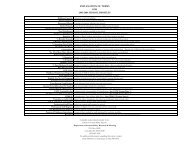The EE Sampler - Jefferson County Public Schools
The EE Sampler - Jefferson County Public Schools
The EE Sampler - Jefferson County Public Schools
You also want an ePaper? Increase the reach of your titles
YUMPU automatically turns print PDFs into web optimized ePapers that Google loves.
Rain Gardens: What, Why, and How?<br />
Kristen Barnes<br />
Why are rain gardens important? As impervious surfaces increase throughout many<br />
neighborhoods, storm water runoff is becoming a growing problem. Pesticides and yard<br />
waste, coupled with oil and gasoline from cars, are washed into storm drains. As pipes<br />
reach capacity, contaminated water often ends up in local streams or rivers, where the<br />
aforementioned chemicals are a big concern. Creating a rain garden can help relieve<br />
several of these problems, lessening the amount of water flooding storm drains, as well as<br />
filtering the run-off , decreasing pollution reaching streams by up to 30%.<br />
What exactly is a rain garden? Many homeowner's can set aside areas of their lawns<br />
for a rain garden, which is a garden designed to collect rainwater from gutters and<br />
downspouts. An area of ground is dug out, which allows water to be absorbed into the<br />
ground--instead of quickly running into storm drains. <strong>The</strong> plants used in rain gardens<br />
have complex, deep root systems, which allow excess water to be both absorbed and<br />
filtered by the plants. Grass possesses only a simple root system, therefore can't absorb<br />
water from storm runoff.<br />
How can I make my own rain garden?<br />
When planning the location of your rain garden, you should consider how storm water<br />
will be directed toward it. Downspouts should be easily accessible or directable to the<br />
garden.<br />
You must also consider the quality of the soil. It needs to allow the water to drain<br />
properly, otherwise pooling will occur, likely leading to continued runoff and<br />
flooding. Most gardens will be dug several inches deep, and drainage quality can be<br />
tested by whether or not water can drain within a 24 hour period. If this isn't the case,<br />
the soil at the bottom of the garden can be replaced with a mix of compost, sand, and<br />
topsoil.<br />
<strong>The</strong> plants used in your garden are your choice, but there are some general guidelines<br />
that are helpful to follow. You should consider the location of your garden, and how<br />
much sunlight it will receive daily. Some plants need direct sun to flourish, while<br />
others prefer more shaded areas. Choosing local, native species is also helpful when<br />
trying to establish your garden, as they will be in the proper climate, and will likely<br />
possess the complex root systems necessary to properly filter rain water.<br />
For Further Information on why and how rain gardens can help you, consult:<br />
www.msdlouky.org -Louisville Metro Sewer District guideline for rain gardens<br />
http://raingardens.org/docs/Create_A_Rain_Garden.pdf -A Michigan based<br />
publication, with good general information on rain garden design and maintenance.<br />
16
















